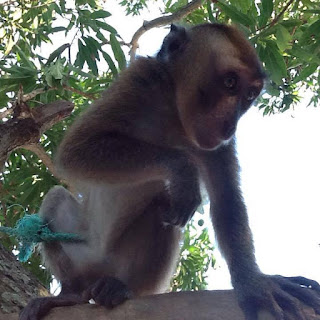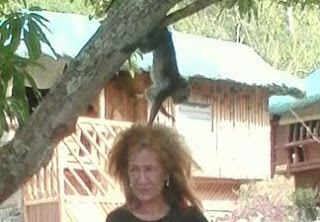******************
May 2016I haven't written here in such a long time. And so much has been happening on the Isla.

There are now three kubos, each sleeping up to 4 people and two stone units which can also accommodate 4, although I suspect, with the popularity of family holidays, might have accommodated an occasional 'floor sleeper' on a mattress.
The kubos are 1500 pesos for the night and the stone units are 2500 pesos for the night. I've written before about the kubos. the traditional small hut made from bamboo and palm thatch. When the resort was built, the idea was to offer a holiday destination that was affordable for a normal working Filipino family to get away from the stress of the city. Even if it was only for a night or two.

But considering that 1500 pesos is about $40 Australian, a couple travelling together can stay in one of these traditional huts for about $20 each per night. Even the stone units at 2500 pesos a night mean a couple would pay about $35 each. Yes, there are hotels in the big tourist spots that are not much different in price, but they don't offer the peace and calm of a small tropical island.

We have had International guests since the very earliest days when the resort was still being built, and last month we had a couple from Ireland who stayed in one of the kubos. But for the genuine back packer on a tight budget there's yet another option.

During this year, Jo and Tess added a camp ground. It is on the high ground, up behind the kubos and a short, pleasant walk from the sea. There are some cement slabs to pitch tents on so that they are not on the ground if it rains. And there is still room on the ground for a few more tents. The camp site fee is the same whether you use the resort tents or prefer to bring your own, but it is very affordable.

The resort can supply 2 or 4 person tents with bedding for 300 or 600 pesos per night. Now, that is the cost of the tent and bedding, So for example, a 2 person tent is 300 pesos, which is about AUD$4.50 for a night. For the tent - or site. That means a couple will pay less than AUD $2.50 per person to camp at Isla Verde.

There are charges for providing a bonfire and if you don't bring your own food and utensils, there's the cost of meals. But even those are cheap.

Getting to Isla Verde is relatively easy because it takes only an hour and a half or so by bus from Manila to Batangas, then a short ride in a Jeepney or Tricycle to the beach where the bancas depart. The Banca is the traditional Filipino boat, like a canoe with outriggers. The type used as a ferry between islands is large and powered by a truck engine. Isla Verde is only abot 5 miles from the mainland, so it is not a big trip, although it can take about 45 minutes because it is not a direct trip.

The morning banca leaves around 9am and arrives at Isla in time for guests to enjoy a pleasant (short) walk to arrive at the resort before lunch. The whole island is only about 7 klm by 4 klm. Departing however, usually means being at the beach on isla around 4am because the return boat is taking workers and school kids across the passage.

Aussies who have stayed on the uninhabited Queensland Great Barrier Reef islands will have an idea what to expect staying on Isla Verde. The difference is that Isla is inhabited. I think the closest thing I can recall to the feeling of Isla would be to combine Magnetic Island, off Townsville and Cid Harbour in the Whitsundays. Like Magnetic Island, Isla Verde is a community of its own, but less touristy. But the actual island itself has more in common with Cid Harbour in appearance and climate.

The Philippines is not as popular as a holiday destination for Aussies as Bali and Bangkok, which is a shame. The Australian Government actively discourages Australian tourism due to some apparent risks to tourists, and the airlines and travel agencies virtually ignore it.

Walk into any of the major travel agency chains and look around and you'll see what I mean. Standard airfares between Australia and all three places are about the same, but there are incredibly cheap specials available often to Bali and Bangkok. Manila is left out in the cold. And if you look around the brochures, The Philippines is remarkable for its lack of presence.

This is a ridiculous state of affairs. The Philippines has more to offer than many other places, not the least of which is that English is its second official language. Add to that the warmth and friendly welcome from people everywhere you go and the most amazing variety in scenery and weather and you have the ideal holiday destination.

And Filipinos LOVE their food. Much of the meat you eat will be pork or chicken or seafood. Steaks are a rarity. But hey - there are dead cows to nibble on all over most countries. And of course another staple is rice. but it is the interesting things that Filipinos do in between the chicken, pork, fish and rice than makes Filipino food different.
I discovered that the first time my girlfriend handed me an amazing 'green mango shake' one night when we were strolling along the esplanade at Manila watching the fireworks.






































